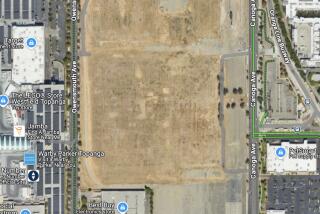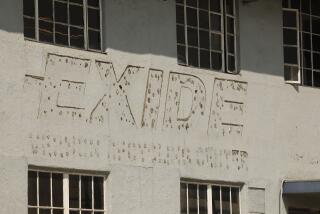Deadly chemical weapons, buried and lost, lurk under U.S. soil

Redstone Arsenal, in the swampy lowlands of northern Alabama, is the largest of the 249 sites in 40 U.S. states and territories where chemical weapons remain buried and await cleanup at a cost of billions of dollars.
- Share via
REDSTONE ARSENAL, Ala. — Yanking aside a tree branch, Jason Watson peered into a waterlogged trench. He pointed out discolored metal drums sunk halfway in the water.
“Blister agents, choking agents, blood agents,” Watson said, listing the array of chemical weapons inside thousands of metal containers that were buried on this 38,000-acre base after World War II.
Watson is part of a team charged with finding, identifying and eventually cleaning up 17 long trenches that snake for six miles, crammed with World War II chemical agents and munitions. Watson, 37, figures he’ll be long retired by the time the job is finished.
“Even if we tried to do this as fast as anybody could ever get it done, we’re talking decades and decades,” Watson said. “The sheer mass of this stuff is overwhelming.”
Even as the United States pushes Syria to surrender its chemical weapons for destruction in a matter of months, this country has struggled for decades with its own deadly stockpiles.
Redstone Arsenal, in the swampy lowlands of northern Alabama, is the largest of the 249 sites in 40 states and territories where chemical weapons remain buried and await cleanup at a cost of billions of dollars. Just outside the Redstone gates is Huntsville, a city of nearly 200,000 residents.
As World War II ended, the United States military collected chemical weapons from Nazi Germany and Japan, as well as from British and American stockpiles. A million chemical weapon munitions marked for storage or disposal were shipped to Redstone, where the U.S. had produced blister agents and other chemical weapons during the war.
Some of the material was burned or blown up. Some was stored in stockpiles. What remained was stacked in trenches and buried.
Today a toxic stew of some of the most lethal weapons ever devised rests beneath the surface: Nazi mustard, a liquid blister agent. Lewisite, another blister agent. Adamsite, a vomiting agent. And possibly Nazi tabun, a nerve agent. Also buried are containers of white phosphorus, chlorine, smoke bombs, tear gas and incendiary bombs.
“This stuff is very dangerous to dig up,” Watson said. “It’ll hurt you. It will blister you up. If you get that nerve agent on you, it will kill you.”
Redstone administrators have been trying since the 1970s to figure out just where all the weapons are buried. In 2010, the base began a state-mandated effort to map its buried chemical weapons sites and eventually dispose of the material.
In a 2012 report, the National Research Council called Redstone “the largest and most challenging” of the buried chemical weapons sites. Communities nationwide are home to these often-little-known repositories.
Several miles southeast of Huntsville at the former Camp Sibert, wide fields used for hunting and cattle grazing cover at least 13 stockpiles of deadly mustard and phosgene gas — directly adjacent to several business and industrial sites.
In the elegant Spring Valley neighborhood of Washington, not far from the White House, teams have dug into the earth in a $230-million effort to clean up World War I chemical weapons dumped there. No records were kept, but experts have searched for mustard, arsenic and other chemicals buried and forgotten almost a century ago.
The cleanup team at Redstone is scheduled to start work in the trenches next year, but it won’t actually start digging up the material until about 2019. Disposal is due to be completed in 2042, and that’s a conservative target. Experts estimate that only about six munitions a day can be safely removed.
The team expects to pull out roughly 388,000 munitions or partial munitions from the trenches. Of that, an estimated 20,000 to 25,000 buried chemical weapons are still intact. They are relatively stable in the ground, but volatile once disturbed. An estimated 600,000 nonlethal munitions containers also could be buried here.
In 1946, burying chemical weapons for what was thought to be safe long-term storage seemed like a good idea, especially in rural, sparsely populated northern Alabama.
“At the time, it was the accepted process for getting rid of this stuff safely,” said Terry de la Paz, chief of the installation restoration branch at Redstone, who has been wrestling with toxic cleanup since 1995.
“They thought putting it in wet areas was a grand thing to do because it was so soggy and nasty, nobody would go in there,” De la Paz said.
Few residents of Huntsville are aware that tons of chemical weapons are buried underground nearby, Watson said. De la Paz said that when they are told, “the first question people ask is, ‘Is it near my house?’ When the answer is no, they lose interest.”
No chemical agents have been detected in groundwater at Redstone so far. However, solvents associated with production and demilitarization of chemical weapons have been found, and they pose a risk to humans, De la Paz said. The Army has imposed tight restrictions on public use of groundwater, she said, and is formulating plans for cleanup.
These days, Redstone is a sprawling, busy Army installation where NASA also carries out rocket testing at the George C. Marshall Space Flight Center. The base is surrounded by residential areas home to soldiers, officers, scientists and engineers, as well as schools, churches and shopping centers.
Compared with the complicated chemical weapons quagmire at Redstone, removing 1,300 tons of intact chemical weapons secured in military hands in Syria seems as simple as trucking the weapons to ships and sailing away for destruction at sea.
“In Syria, you know where the weapons are and what they are, and they can move them with a forklift,” Watson said, stomping through the woods past a sunken patch of earth that held a weapons trench. “Here, we don’t know. We have to go out there and dig them out of the ground, not knowing exactly what’s in there or where it is.”
President Nixon declared a moratorium on new production of chemical weapons in 1969. In 1985, the U.S. declared its chemical weapons stockpiles obsolete and said they should be destroyed.
By the time the U.S. in 1997 signed the Chemical Weapons Convention, an international treaty outlawing production, stockpiling and use of chemical weapons and their precursors, the country was stuck not only with buried weapons at sites such as Redstone, but also with stockpiles totaling 31,500 tons of chemicals in mortar and artillery shells, rockets and other lethal weapons. Most contained mustard or the nerve agents sarin and VX.
In 1990, the process of incinerating those weapons began at eight sites in the U.S. and on Johnston Atoll in the Pacific. Nearly 90% of the job was completed by April 2012, leaving only two chemical weapons stockpiles, in Pueblo, Colo., and Blue Grass, Ky.
Disposal by incineration was halted because of environmental concerns, and the remaining 10% is now set to be destroyed by a chemical process. The rough target dates for completion are 2017 for the Colorado stockpile and 2021 to 2023 for the one in Kentucky.
“It’s a very expensive and time-consuming process,” said Karen Jolley of the Army’s Joint Project Manager for Elimination agency. “Our grandkids will be working on this.”
The U.S. has rid itself of some chemical weapons by burying them at sea. There were about 72 separate disposals in the Atlantic, Pacific and Indian oceans and Mediterranean Sea. Dumping chemical weapons at sea was banned by Congress in 1972, but there is no plan to clean up the underwater sites. Congress has authorized two studies to explore ways to dispose of those chemicals.
At Redstone, meanwhile, the disposal team pores over old mapping photos, land maps and shipping records to try to determine exactly what chemical weapons were buried where.
Recently, Watson and De la Paz, 51, hiked down a gravel road to reach an old limestone quarry in a remote wooded section of the Redstone base. Embedded in packed dirt along the quarry’s stone walls are rusted gas-mask cartridges and containers, dumped decades ago.
In the quarry’s clear, blue-green waters, dark shadows are detectable along the shoreline — rusting metal drums like the ones buried in the trenches. The drums could contain chemical weapons residue, dumped there along with mortar rounds and old Navy mines.
“They buried stuff everywhere,” Watson said, staring down into the water.
At some point, perhaps before retirement, members of the team will try to clean up that mess too.
More to Read
Sign up for Essential California
The most important California stories and recommendations in your inbox every morning.
You may occasionally receive promotional content from the Los Angeles Times.











